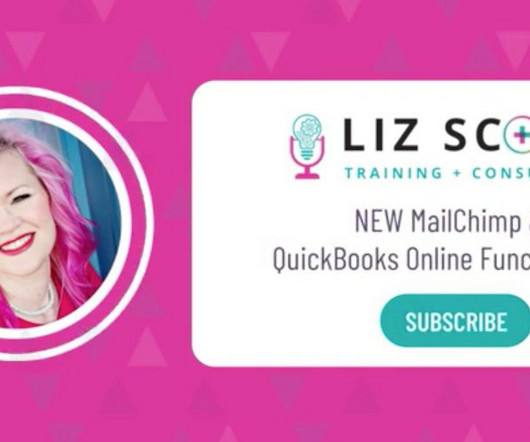Tax Planning for Digital Assets
Insightful Accountant
JULY 23, 2023
Summit Tax & Accounting Advisors’ Rene Carlos examines how to prepare for the tax implications of digital assets.

Insightful Accountant
JULY 23, 2023
Summit Tax & Accounting Advisors’ Rene Carlos examines how to prepare for the tax implications of digital assets.

Accounting Tools
JULY 23, 2023
Related Courses Cost Accounting Fundamentals Financial Analysis What is Cost? Cost is the expenditure required to create and sell products and services, or to acquire assets. When sold or consumed, a cost is charged to expense. In the case of an asset, the charge to expense could be significantly deferred. The cost concept underlies the transition of assets from the balance sheet to expenses in the income statement.
This site is protected by reCAPTCHA and the Google Privacy Policy and Terms of Service apply.

Insightful Accountant
JULY 23, 2023
Liz Scott rolls through the buzz surrounding the direct integration between QuickBooks Online and MailChimp. Check out her thoughts—and video—to see how you can explain the functionality to your clients.

Accounting Tools
JULY 23, 2023
Related Courses Bookkeeping Guidebook How to Audit Receivables New Controller Guidebook What is a Bad Debt Reserve? The bad debt reserve is a provision for the estimated amount of bad debt that is likely to arise from existing accounts receivable. A large reserve may be caused by low-quality customers, which may in turn be caused by a company's reduced attention to screening the financial condition of prospective customers.

Speaker: Victor C. Barnes, CPA, MBA
In the climb from contributor to leader, the rules quietly change. But if you’re aiming for the summit, the air gets thinner, and what got you here won’t be enough to get you to the top. 🗻 What made you successful early in your finance career—technical accuracy, sharp analysis, flawless execution—won’t be what carries you to the next level. The higher you go, the more your effectiveness depends on how you connect, adapt, and communicate.

Accounting Tools
JULY 23, 2023
Related Courses Credit and Collection Guidebook Effective Collections What is Cash on Delivery? Cash on delivery is payment terms that require the recipient of a delivery to make full payment with cash or a certified check at the time when goods are delivered to the recipient. The shipping company collects the payment and remits it to the seller. If the recipient cannot pay, then the shipping company returns the goods to the seller.

Accounting Tools
JULY 23, 2023
Related Courses CFO Guidebook Investing Guidebook Investor Relations Guidebook What is a Secondary Market? A secondary market is any market in which financial instruments or other assets are bought and sold among investors. Prices are set in a secondary market based on supply and demand. The bulk of all trading occurs in secondary markets. The only parties not involved in a secondary market are the initial issuers of financial instruments or other assets.
Financial Ops World brings together the best financial operations content from the widest variety of thought leaders.

Accounting Tools
JULY 23, 2023
Related Courses The Balance Sheet The Interpretation of Financial Statements What are Net Quick Assets? Net quick assets are the aggregate amount of a firm’s cash, marketable securities , receivables , and current liabilities. The measure excludes inventory , which can be difficult to liquidate within a short period of time. Net quick assets can be used to gain an understanding of an organization’s ability to settle short-term obligations with assets that are easily convertible into cash.

Accounting Tools
JULY 23, 2023
Related Courses Human Resources Guidebook Optimal Accounting for Payroll Payroll Management What is Accrued Wages? Accrued wages refers to the amount of liability remaining at the end of a reporting period for wages that have been earned by hourly employees but not yet paid to them. This liability is included in the current liabilities section of the balance sheet of a business.

Accounting Tools
JULY 23, 2023
Related Courses Corporate Finance Credit and Collection Guidebook What is a Standby Letter of Credit? A standby letter of credit is a guarantee by a bank to pay a third party if a client of the bank is unable to do so. This arrangement is sometimes demanded by a third party that wants to ensure itself of the credit quality of a prospective customer, especially in international trade deals.

Accounting Tools
JULY 23, 2023
Related Courses Credit and Collection Guidebook Effective Collections Essentials of Collection Law What is the Procedure for Collections? The collections staff may deal with an enormous number of overdue invoices. If so, the collection manager needs a procedure for dealing with customers in a standardized manner to resolve payment issues. The detailed collection procedure is listed below.

Speaker: Kim Beynon, CPA, CGMA, PMP
The most overlooked, yet most critical, element of transformation is preparing people for change. Automation and AI aren't just technical upgrades, they’re cultural shifts which can challenge identities. That’s why change management isn’t a side project—it’s the foundation. In finance, where precision and process rule, navigating change can feel especially disruptive.

Accounting Tools
JULY 23, 2023
Related Courses Revenue Recognition The Income Statement What is Other Income? Other income is income derived from activities unrelated to the main focus of a business. For example, a manufacturer of washing machines earns rental income from sub-leasing unused office space to a third party; this rental income would be classified as other income on the company’s income statement.

Accounting Tools
JULY 23, 2023
Related Courses C Corporation Tax Guide S Corporation Tax Guide What are the Characteristics of Corporations? Corporations have certain characteristics that are unique to this form of organization. These characteristics are noted below. Capital Acquisition It can be easier for a corporation to acquire debt and equity , since it is not constrained by the financial resources of a few owners.

Accounting Tools
JULY 23, 2023
Related Courses Accounting for Investments Investing Guidebook What is a Liquid Investment? A liquid investment is any investment that can be easily converted into cash without having a significant impact on its value. Examples of liquid investments are cash, money market funds, and shares of publicly held companies that actively trade on an established stock exchange.

Accounting Tools
JULY 23, 2023
Related Courses Investing Guidebook What is an Equity Interest? Equity interest is the ownership share of a shareholder in a business. For example, having a 15% equity interest in a company means that a shareholder owns 15% of the business. An equity interest does not necessarily mean that a shareholder is entitled to a proportionate share of the income generated by an investee.

Speaker: Mark Gilham, FCCA, CPP
Finance used to be the function that counted, now it's the one that’s counted on. 📊 For accounting firms, controllers, and finance leaders, expectations are rising faster than headcount. Businesses want agile forecasts, granular analysis, seamless reporting, and smart automation—often without added resources while demanding uncompromised accuracy and compliance.

Accounting Tools
JULY 23, 2023
Related Courses The Balance Sheet What is an Accumulated Dividend? An accumulated dividend is a dividend on cumulative preferred stock that is due but has not yet been paid. This dividend is an obligation of the corporation , so it is recorded as a liability on the balance sheet until it is paid. These dividends must be paid before any other dividends can be paid out.

Accounting Tools
JULY 23, 2023
Related Courses Business Combinations and Consolidations CPA Firm Mergers and Acquisitions Divestitures and Spin-Offs Mergers and Acquisitions What is a Controlling Interest? An investor achieves a controlling interest in a business by owning any amount more than 50% of the shares in the entity. Doing so gives the investor significant influence over the actions of the company, including its strategic and operational decisions, since the investor can overturn or veto the decisions of other board
Let's personalize your content